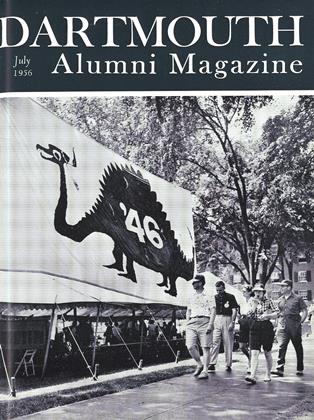ECONOMIC GEOGRAPHY OF INDUSTRIAL MATERIALS. By Albert S. Carlson.New York: Reinhold, 1956. 494 pp. $12.50.
Professor Carlson's book on industrial materials is a new offering in the series of reference books published by Reinhold Corporation. The text, edited by Carlson, is written by twenty-seven specialists in their respective fields. The list includes Dartmouth men Robert Monahan '29, writing on forest products, and Prof. Trevor Lloyd, who wrote the chapter on nickel. Individuals in private businesses and several professors in leading institutions contributed chapters, as did the following national organizations: American Iron and Steel Institute, Aluminum Association, National Coal Association, Lead Industries Association, National Cottonseed Products Association, American Petroleum Institute, and the United States Department of Agriculture.
The text is planned as a reference to the more important materials and basic industries that are a part of the present-day industrial organization, focused primarily on the United States. These are treated under the headings: 1) Resources and Transportation, 2) Fuel and Power, 3) Products from Minerals, 4) Natural and Synthetic Products, 5) Agricultural and Food Products.
The chapters are organized, within the limits of the individual topic, following a general outline which includes the location of the facilities, raw materials needed and their sources, factors of plant location, markets, transportation, costs, tariffs, and production. Most of the chapters are profusely illustrated with tables, charts, graphs, maps, and photographs; over 300 in the book. More than half the chapters include a short bibliography and reference.
The material covered in the different chapters varies somewhat. The chapter on transportation seems to be more elementary and less comprehensive than many of the others. The chapters on iron and steel, aluminum, forest products, and paper and pulp, for example, are well done, giving a good overall picture of their respective industries. The plastics industry, unfortunately, is not listed in the table of contents and is relegated to a page in the appendix. Logically, it should follow the chapter on synthetic organic chemicals. The numerous tables and graphs give additional, up-to-date figures on production, costs, trends, and comparisons. The other illustrations, for the most part, are clear, informative, and well chosen. A few of the maps, particularly in the chapter on food and agriculture, are difficult to read.
This book is a new and advanced approach to the field of economic geography. The editor has eliminated, almost entirely, "the elementary geographic data that appear in beginning texts for this field and has assembled a group of comprehensive studies on specific topics, the scope of which would be hard to find within the bindings of any other one book. Among the topics seldom included are those on the nickel industry, sulphuric acid industry, titanium, phosphate rock, and synthetic organic chemicals. As stated above, the text is focused primarily on the United States, and a subsequent edition, or a companion volume, might well include the world situation in the materials industries.
This book should be a welcome edition to business and industrial schools, to industry, and agencies concerned with industrial materials. Unfortunately, the price ,of the book will undoubtedly limit to advanced students its use in the various institutions.
 View Full Issue
View Full Issue
More From This Issue
-
 Feature
FeatureThe Honorary Degree Citations
July 1956 -
 Feature
FeatureThe 1956 Commencement
July 1956 By FRANK PEMBERTON -
 Feature
FeatureThe Fifty-Year Address
July 1956 By THURLOW M. GORDON '06 -
 Feature
FeatureGeorge Nickum '31 to Head Alumni Council for 1956-57
July 1956 -
 Feature
FeatureThe Seniors' Valedictory
July 1956 By WILLIAM FREDERICK BEHRENS '56 -
 Feature
FeatureThree Alumni Honored For Service to College
July 1956








